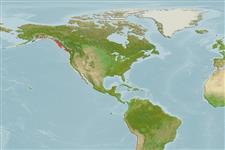Common names from other countries
Classification / Names / Names
Common names | Synonyms | Catalog of Fishes (gen., sp.) | ITIS | CoL | WoRMS
Malacostraca >
Decapoda (Lobster, shrimp and crabs) >
Lithodidae (stone and king crabs) > Lithodinae
Environment: milieu / climate zone / depth range / distribution range
Ecology
Benthic; depth range 0 - 30 m (Ref. 865). Temperate
Eastern Pacific: Alaska, USA and Canada.
Length at first maturity / Size / Weight / Age
Maturity: Lm ? range ? - ? cm Max length : 7.5 cm CW male/unsexed; (Ref. 865)
It is found on rocky substrates from shallow waters to a depth of 30 meters (Ref. 865).
Life cycle and mating behavior
Maturity | Reproduction | Spawning | Eggs | Fecundity | Larvae
Members of the order Decapoda are mostly gonochoric. Mating behavior: Precopulatory courtship ritual is common (through olfactory and tactile cues); usually indirect sperm transfer.
Bisby, F.A., M.A. Ruggiero, K.L. Wilson, M. Cachuela-Palacio, S.W. Kimani, Y.R. Roskov, A. Soulier-Perkins and J. van Hertum. 2005. (Ref. 19)
IUCN Red List Status (Ref. 130435)
CITES status (Ref. 108899)
Not Evaluated
Not Evaluated
Human uses
| FishSource |
Tools
More information
Age/Size
Growth
Length-weight
Length-length
Morphology
Larvae
Abundance
Internet sources
Estimates based on models
Preferred temperature
(Ref.
115969): 5.8 - 12.4, mean 8.5 (based on 329 cells).
